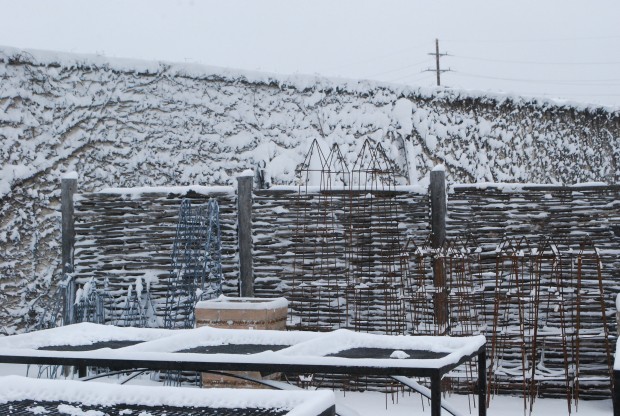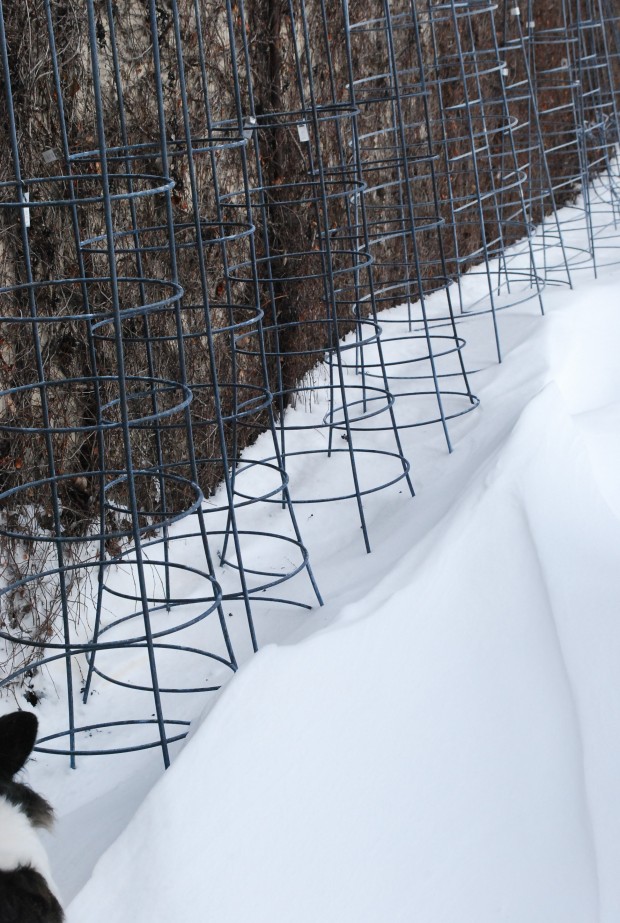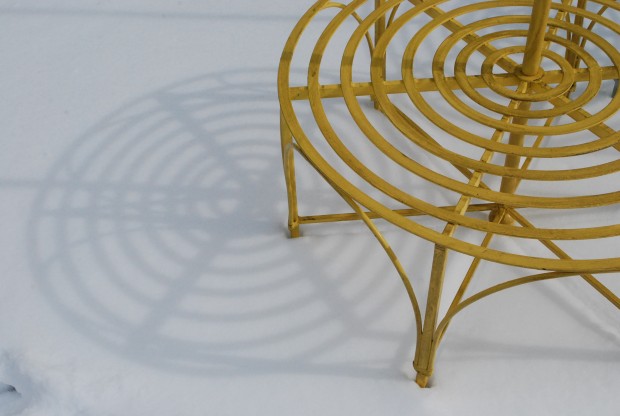 I know how deep the snow is the moment the corgi legs disappear-8 inches. The snow we had last Friday-as you can see, just about 8 inches. A decent show. Not at all like the overwhelming snow dumped on the northeast. If you are digging out of 18 inches or more, you have my concern and sympathy. However, our modest 8 inches transformed the landscape. All the little bits and pieces close to the ground disappeared from view. The shapes of the snow were governed by the wind. All that could be seen-the big picture.
I know how deep the snow is the moment the corgi legs disappear-8 inches. The snow we had last Friday-as you can see, just about 8 inches. A decent show. Not at all like the overwhelming snow dumped on the northeast. If you are digging out of 18 inches or more, you have my concern and sympathy. However, our modest 8 inches transformed the landscape. All the little bits and pieces close to the ground disappeared from view. The shapes of the snow were governed by the wind. All that could be seen-the big picture.
Much of what a good designer provides resides in their ability to focus on the big picture. The simple picture- the important and pertinent picture. This is not an easy or God given ability. It takes work to develope an eye that sees like this. I find my experience as a gardener, my long standing interest in design, and my abiding love for the natural world enables me to help clients-some clients better than others. As for my own landscape-I am floored. I can barely help myself. I focus on the details that either don’t matter, or are too early in the process to matter. That said, I understand why people who love the garden enough to want good design call me. A landscape is a big investment emotionally, and financially. If you love it, and if you plan to put any amount of money to it, you can’t afford not to hire someone to help frame the big picture. This recent 8 inch blanket of snow has me thinking about those issues. The above picture has no scale or reference. No relationship to anything else. The twigs might be photographed against the sky. Or the ground. Where are we here? A little visual vertigo is at work here. landscapes without any point of view give me the same feeling. The designed landscape is composed. It has an idea. It has stars and supporting cast members that interact. It has a back story. There is tension, rhythm and release. There are places to be, places to see, and a mean by which to navigate both physically and visually.
Falling snow and wind creates shapes and spaces. Plateaus. Mountains-and voids. Heavy snow creates a momentary landscape. An utterly simple landscape. The landscapes created by nature have plenty to say to those of us who design landscapes. Great landscape design addresses shapes, mass, line, volume, texture, color-and use. Though natural shapes made by the snow are driven by climate, weather, ecology and topography, the design elements are the same.
The back edge of my boxwood hedge had just a few sprigs showing after the storm. It is easy to see the shape, even though most of the detail is buried in snow. This photograph is graphic. Black and white. There is no visual description of the space. No variation in color. No shadows. No point of reference.
The snow that covered the base of this topiary form was just enough to describe what lies beneath it. The shadows and volumes describe a shape-and a space. There is visual interest. How might this translate to the landscape? A slightly sunken circle of groundcover will have much more visual impact than a circle of groundcover set at grade. If you mean to install a circular shape, do it accurately. Lopsided execution is irritating. A circle of groundcover on a slope-be sure you intend to feature an ellipse. A shape such as the snow describes here would have to be planted with a very finely textured and low growing plant, for the shape to read.
The thoughtful use of mass and texture in the landscape can create and sustain great visual excitement. The smooth texture of the horizontal layer of snow in contrast to the interplay of snow describing the shapes of the leaves in the vertical-beautiful. The upper mass of snow is connected to the ground level mass of snow by a vertical and highly textured shape. This snow composition features volume.
The repetition of shapes, or the discussion of a single shape, makes a stronger and clear statement. This urn has several layers of circles. One layer is defined by repeating spherical shapes. The base is round. The snow clings to the circular rim of the urn. Your eye understands that the urn has a rim, and an interior well. The snow in the center sank under its own weight. The sunken shape-a half sphere. The wind whipped the ground snow in a wider that perfect circle around the base. There’s a visual discussion of circles and spheres going on here that is striking.
The relationships between shapes, masses, lines, textures and space is made so clear by the snow. I know what walls, fences and tables are. I know what objects these words describe. But the snow makes me see them as shapes. I know that the partial table is near to me, and the wall is further away. And that the electric pole is very far away. God landscape compositions make a visual description of the space being viewed. Though it is very hard to describe in words how a composition can be spacially rich, a snow storm can help me see it.
Color is a very important element of the landscape. How light affects color is an equally important element. The blue sky behind the copper willow makes that willow glow. The blue sky relates to the blue shadows on the snow. The out of focus blue gray fence in the center left of this picture helps the composition to work spacially, edge to edge. Edge to edge? This picture has 4 sides that frame the view. There are many ways of framing a landscape view. Trees. A pergola. A pair of pots. A fence with its gate open. Framing the view is an invitation to enter, and interact. Where would you frame the view? Up close? Far away? These are decisions that need to be made deliberately.
So many elements in the landscape have interesting surfaces. In this case, snow reflecting the sun. Stone, leaves, sky, flowers-every element in the landscape has a particular surface. The relationship of one surface to another tells a story. All the same surface-as in what was created by the snow we had-enchanting for the first three days, and thereafter monotonous and stifling.
Checking out the compositions created by our snow-engaging.
It does make me really crabby if the mailman walks across the snow in my front yard to get to the mailbox. I actually asked him to use the sidewalk. I am sure he thought I was nuts, but I don’t care. Experiencing that snow exactly as nature engineered it is the best part of the winter season. I do not disturb any snow unless I have to. Who knows how many days it will take for the visual lessons to sink in.
If you are digging out, I am sure you are thinking about the most efficient way to get from one place to another. Milo is pretty good at designing paths. His snow paths have to do with how fast and efficiently he can make the left turn coming out of the front door, to a destination down the driveway. That curve is is particular to him. In much the same way as a landscape design is particular to a certain gardener.











